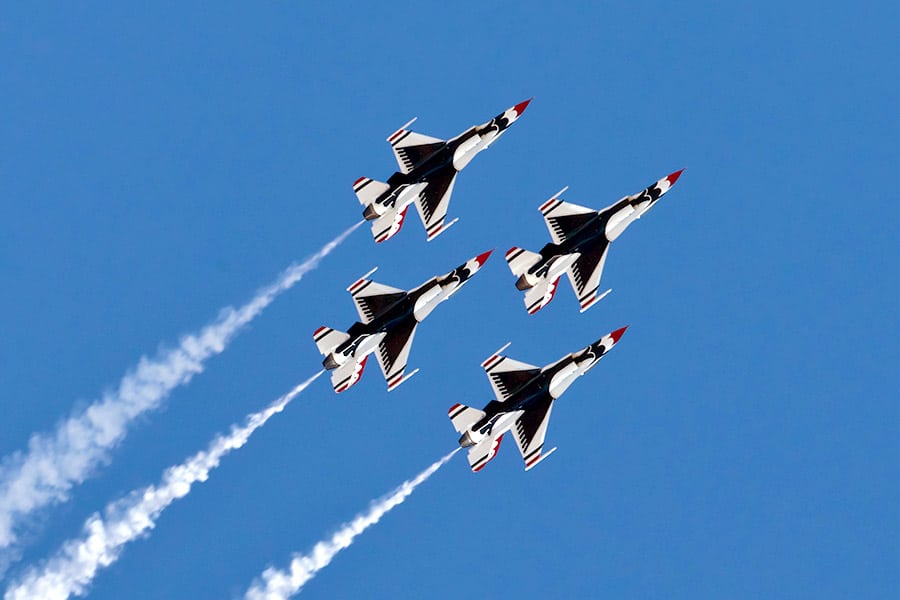
Known as the “Gateway to the Pacific,” Travis Air Force Base is among the busiest military airports in the United States. First opened in 1943 and originally named the Fairfield-Suisun Army Air Base, it played a vital role during World War II—ferrying supplies, soldiers, and aircraft to the Pacific Theater of war. Today, the base is home to thousands of U.S. Air Force Military and Reserve Personnel, and their families. But where is it located?
Travis Air Force base is located east of Fairfield and south of Vacaville, California, on the southern edge of the Sacramento Valley. The base is a short drive from popular West Coast tourist destinations, including the Bay Area, Napa Valley, Lake Tahoe, and Sacramento.
Travis Air Force Base (Travis AFB ) is still a fully-functioning military base with regards to its cargo, passenger, and handling of humanitarian aid efforts worldwide, and it also offers a number of dining, leisure, and other exciting activities to its visitors. With on-base lodging, golf courses, recreation for kids and teens, as well as some of the best local restaurants in all of the Sacramento Valley, the base has become as important to the community surrounding it as the military members it houses.
To discover more about Travis AFB’s history, as well as details of its location and the fantastic activities therein, continue reading.
Where is Travis Air Force Base?
Travis Air Force Base is specifically a part of Solano County, in Northeast Fairfield; the base also borders Suisun City and Vacaville. The close vicinity to the former two garnered its initial namesake of Fairfield-Suisun.
And, speaking of its name, the base was officially renamed in 1951 after Brigadier General Robert F. Travis, who served valiantly as a general in the United States Army Air Force during World War II (more on General Travis later).
With that in mind, the base serves as a somewhat large dividing point to various locations that border Solano County and Fairfield. However, it also is located only three miles from the city’s center.
How far is to Travis Air Force Base from:
- Lake Tahoe, CA – 147 miles
- Los Angeles, CA – 390 miles
- Napa, CA – 26 miles
- Reno, NV – 171 miles
- Sacramento, CA – 41 miles
- San Francisco, CA – 54 miles
- San Jose, CA – 85 miles

How Big is Travis Air Force Base?
The base is immensely expansive, covering almost 6,383 acres of land in the Sacramento Valley, east of Fairfield. Additionally, with 1,720 various buildings on base, including residential, aircraft bunkers, command centers, and any other structures such as the PX or Commissary, all those buildings’ total size is approximately 9,668,509 square feet.
A Brief History of Travis Air Force Base
As mentioned previously, Travis Air Force Base (then Fairfield-Suisun Army Air Base) first began operations in May 1943, after starting construction in 1942. Initially, it was designed to house medium-attack bombers and more U.S. Navy aircraft but, in October of 1942, Air Transport Command was given authority over the area. With its close vicinity to the Pacific Theater during the war, the base proved essential in transporting troops and supplies toward the frontlines.
However, what began as a single isolated airstrip with tarp barracks, the base grew in size, scope, and use over the ensuing years. In 1947, it was renamed Fairfield-Suisun Air Force Base in conjunction with the establishment of the U.S. Air Force.
In 1949, Strategic Air Command (SAC) used the base as a “major long-range reconnaissance and bombing installation for the 9th Bomb Wing.” This implementation as a SAC furthered the base’s infrastructure that would continue over the following decade, eventually garnering the title “Gateway to the Pacific” for its role as the primary military airlift hub in the western U.S.
Other Posts of Interest
- Can You Walk Down Lombard Street in San Francisco?
- Where Can I Watch The San Francisco Giants Play?
- Is San Francisco Expensive for Tourists?
- Does San Francisco Get a Lot of Earthquakes?
Bay Area Answers Fun Fact: Travis Air Force Base is the home base of the United States Air Force Band of the Golden West, a group of about sixty talented Airmen musicians. Approximately 1.5 million people annually are treated to outstanding musical performances by the band, and you might have even seen them performing at the Tournament of Roses parades in the past.

How Did Travis Air Force Base Get its Name?
With its progressive importance throughout history, its usage providing continued support to a growing U.S. Air Force and proving itself to be an invaluable asset to military command nationally during those formative years, the base also received the name it would become known for.
A brigadier general and hero of World War II, Robert F. Travis, was on board a B-29 Superfortress holding a Mark 4 Nuclear weapon when the plane unexpectedly crashed shortly after take-off, taking the life of Brigadier General Travis and eighteen others. The General was very popular, and in honor of his service, in 1951, the base was renamed Travis Air Force Base.
What is the Current Role of the Base?
Travis Air Force Base is currently home to the 60th Air Mobility Wing, the largest wing of Air Mobility Command, as well as the 349th Air Mobility Wing of the Air Force Reserve command. Servicing all of these aircraft and various groups, Travis is the busiest military airbase in the U.S., running non-stop military missions, hosting training, and proudly offering humanitarian relief efforts worldwide.
In addition, it also plays a pivotal role in the surrounding community, as many Air Force retirees make Fairfield their permanent home. It is an excellent place to set up, as the base is also the largest employer in Solano County, with a massive workforce accounting for nearly $1 billion annually.
What Planes Fly Out of Travis Air Force Base?
The base hosts fleets comprised of top-of-the-line aircraft from the U.S. Air Force, including the C-5 Galaxies, KC-10 Extenders, and C-17 Globemaster IIIs, not to mention those aircraft attributed to the Strategic Communications of the U.S. Navy like the E-6B Mercury TACAMO assigned specifically to the Fleet Air Reconnaissance Squadron THREE (VQ-3).
However, more than those multi-turbine cargo planes and specialized carriers, the base is also home to the Travis Air Force Base Air Show.
Travis Air Force Base Air Show
One of the largest aviation events in the U.S., the Travis AFB Air Show is an annual event that hosts almost one-hundred-thousand people per day. Free to attend and open to the general public, this event hosts various types of aircraft spanning the entire history of the Air Force, harkening back to World War II era fighter-jets, bombers, and even the newest iterations of design from the Air Force.
At the same time, the show is also set to entertain the spectators as the United States Air Force Thunderbirds fly by in remarkable feats of aviation to amaze the crowds as they have since 1952.

Can You Tour the Base?
As with most military bases, a military ID is needed to have access to the base. However, there are a few caveats to that specific rule. For example, as an educational air base, Travis AFB offers tours from the Travis Public Affairs Office twice a year, one in Spring and one in Fall. While priority scheduling is given to ROTC and JROTC students, other high-school/college students, civic and business organizations can call and see about other opportunities.
However, if you do not have a DoD (Department of Defense) ID card, you may still access the Travis Air Force Base Heritage Center and, hopefully for an educational reason, the David Grant USAF Medical Center.
The Travis Air Force Base Heritage Center
With one of the largest military aircraft collections on the West Coast, the Heritage Center is a must-stop museum for anyone visiting the base. With options for non-military personnel to gain access through the “Visitor’s Center” and guest services, this museum offers a stunning history to anyone interested in the inner-workings and outer-magnificence of aviation.
With the museum proudly displaying exhibits on Jimmy Doolittle, the Tuskegee Airmen, the Tokyo Raiders, the Berlin Airlift, and more, along with particular emphasis given to the Korean and Vietnam Wars, this collection has everything to keep an audience of all ages thoroughly engaged.
The David Grant USAF Medical Center
The U.S. Air Force’s largest medical center in the nation, the David Grant Medical Center, is a fully-accredited hospital designed as a teaching hospital. A host of remarkable innovations in medicine, even awarded the National Quality Approval Gold Seal by the Joint Commission, this medical center provides care for more than those in the San Francisco and Sacramento areas. With over 500,000 current DoD beneficiaries and veterans getting help from this extraordinary institution, it benefits not only the local community but also the military nationwide.
Additionally, with a state-of-the-art Aeromedical Staging Facility, the second-largest Graduate Medical Education program of the entire U.S. Air Force, and medical research on the cutting-edge for the war fighter and civilian safety, the David Grant USAF Medical Center is host to a variety of medical advancements and new prevention methods nationwide.
Final Thoughts
With a stunning history that developed from a single airstrip to the bustling military complex that it is today, the Travis Air Force Base, located at the edge of the Sacramento Valley, is a shining example of the progress of the U.S. Air Force from the years since its inception.
The busiest military airport in the U.S., Travis Air Force Base handles daily flights that ship cargo, soldiers, or humanitarian aid and is still called home by thousands of U.S. Air Force Personnel. Not only that, as a host to exceptional innovations in defense and medical technology, as well as public shows displaying the awesome might of aviation, and private tours addressing its remarkable history—the Travis Air Force Base is one of the finest examples of a military complex defending, and serving the nation.





